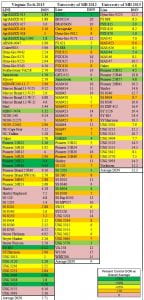Nathan Kleczewski, Extension Specialist – Plant Pathology; nkleczew@udel.edu
The fungus Fusarium graminearum causes Fusarium head blight (FHB) in barley and wheat. Infection of wheat heads by F. graminearum can result in reduced grain fill, bleaching, and the production of a mycotoxin known as deoxynivalenol (DON). Consumption of DON infested grain can result in nausea, vomiting, feed refusal, and reduced weight gain in many animals. As a result, DON levels are regulated by the FDA and many grain elevators test for elevated levels of the toxin (Table 1). If levels exceed a given level, for example 2 ppm for grain destined for human consumption, the load can be docked. In severe cases the load can be rejected.
Table 1. Deoxynivalenol (DON) Advisory Levels established by the FDA.

FHB outbreaks are becoming more frequent in the region due to increased acreages of conservation tillage and corn. The fungus survives on corn and small grain residue and releases spores that can be disseminated locally and over long distances. Thus, it is important that this disease is not forgotten when it comes time to select varieties for the upcoming season. The first step in FHB management starts with the selection of a good, moderately resistant variety. The most important aspect of a moderately resistant variety is its ability to slow the production or accumulation of DON in grain. The difference in DON accumulation between susceptible and moderately resistant varieties can be striking (Table 2). DON accumulation does not correlate well with bleaching of heads, so fields may have elevated levels of DON without showing significant levels of bleaching. This is why selection of a moderately resistant variety should be based off of DON data and not severity or incidence data.
Table 2. Recent results of FHB nursery trials conducted at Virginia Tech and The University of Maryland
These trials use a misting system that reduces disease escapes due to timing of flowering. Varieties are color coded to indicate their DON reduction potential relative to the average DON in a given trial. Dark green = >75% control; light green = >50% control; yellow >25% control; orange = >10% control; red = no control or DON greater than the average. Data courtesy of Carl Griffey, Virginia Tech and Jose Costa, USDA-ARS (Formerly U. Maryland).
When the environment is favorable for FHB, combining a moderately resistant variety with a recommended fungicide application within 5-6 days of the start of flowering can result in roughly 75% reduction in DON relative to untreated susceptible varieties. Fungicide use alone on average suppresses DON by roughly 45%. The tables below provide the most recent DON data for FHB wheat nurseries managed by the University of Maryland and Virginia Tech. DON levels are not absolute, and due to the nature of the resistance there is some variability in the amount of DON suppression from year to year or field to field (Table 2). However, research indicates that moderately resistant varieties provide consistent reductions in FHB and DON. In addition, newer varieties yield well in the absence of disease and varieties continue to be released.
